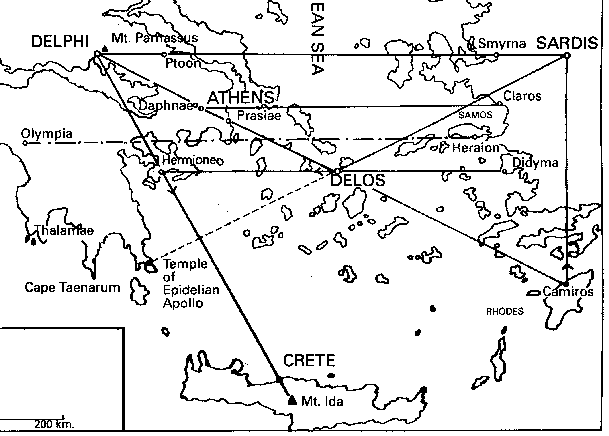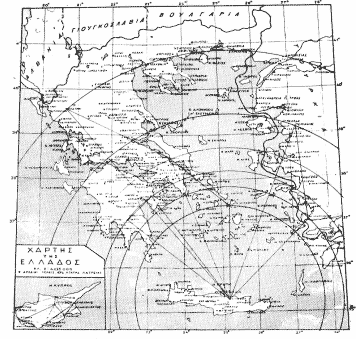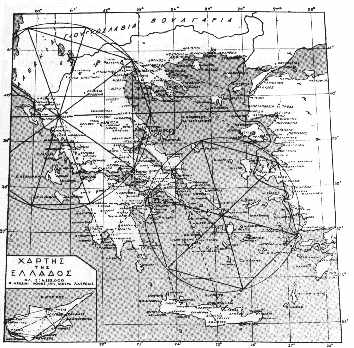|
Location:
Cyclades Islands, Greece. |
Grid Reference:
37 23' 36" N, 25 16' 16" E. |

 Delos:
(Oracle Centre - The 'Floating Island')).
Delos:
(Oracle Centre - The 'Floating Island')).
One
of the most important mythological, historical and archaeological sites
in Greece. Indeed, its location at the centre of the Cyclades gives rise
to the theory that the name of the Cyclades group of islands in the
Aegean sea comes from the word, circle or 'kyklos' that form around the
island of Delos.
The island is famous as the birthplace of the twin gods Apollo and
Artemis.
As well as being an important archaeological site, Delos is connected
geometrically with other important Greek sites and is a part of the
'oracle octave' as proposed by Livvio Stecchini.
(Click here for
Map with location of Delos)
(Click here for
map of Archaeological sites on Delos)
Delos,
along with many of the Greek islands
was first occupied sometime during the 3rd millennium BCE (5). The
importance of the island is made clear in Greek mythology, where it is
said to be the birthplace of Apollo, although it functioned as a religious location and sanctuary long before the Greeks decreed it the birthplace of two
of their most important gods. A number of "purifications"
were executed by the city-state of Athens in an attempt to render
the island fit for the proper worship of the Gods. The first took
place in the 6th century BC, and was directed by Pisistratus, who
ordered that all graves within sight of the temple be dug up and the
bodies moved to another nearby island.
Such was the importance of the island that
In the 5th century, during the 6th year of the Peloponnesian war and
under instruction from the Delphic Oracle, the entire island was purged
of all dead bodies and it was
decreed that no one should be allowed to either die or give
birth on the island due to its sacred importance and to preserve its
neutrality in commerce, since no one could then claim ownership
through inheritance. Immediately after this purification, the first festival of the Delian games were celebrated there.
(Ref: Thucydides, III,104.)
Delos was held in such reverence by most
nations, that even the Persians, after having laid waste the other
islands, and every where destroyed the temples of the gods, spared
Delos; and Datis, the Persian admiral, forbade anchor in the harbour
The Delos oracle was second only to that of Delphi.
|
Chronol0gy
of Delos:
Evidence of the first inhabitants of the island is thought to have
occurred around 2,800-2,500 B.C. Excavations have discovered the
ruins of this pre-historic settlement on the top of the low hill of
Mount Kynthos.
The Ionians arrived
in the 10th-9th centuries and established Delos as a sanctuary to
worship Apollo.
The island reached its climax in
the archaic (7th-8th century B.C.) and classical (5th -4th centuries
B.C.) period after Hellenes from all over the ancient Greek world
gathered there to worship the twin god and goddess Apollo and
Artemis, completing the prophesy by Leto.
For much of its history, the island was a thriving commercial port
with population estimates onward to a staggering 30,000 people.
Under the Romans in the 2nd and 3rd centuries B.C. as many as 10,000
slaves were said to be sold there on some days.
The prosperity of Delos reached an end, following the attack by
Mithridates of Pontus, a monarch from Asia Minor, who went to war
with Rome and conquered the island in 88 B.C., slaughtered its
20,000 inhabitants, and sailed away with ships loaded with the
treasures of the island.
(3) A
census of the island in 2001 counted the population at 14 people. |
Delos in Greek Mythology:
According to mythology, Leto,
pursued by the incensed and jealous goddess Hera, wandered from place to
place seeking some corner of the earth in which to give birth to her
children, the fruit of her union with Zeus, father of the Gods. But all
the Islands and
cities refused to receive her, afraid of the vengeance of Zeus' deceived
consort, whom only a bare rock in the middle of the tempestuous sea
dared to defy.
Prior to this event, the island had
floated aimlessly in the Aegean, but became anchored in its position by
Poseidon who made four granite columns rise out of the sea to anchor it
firmly in its present place for the divine birth. This is why the island
came to be called Delos, which means 'visible', before which it was a
floating, nomadic rock called Ortygia or Adelos (the invisible).
It is said that it was on Delos that Leto
finally bore the twins, Apollo and Artemis under a palm.
In return for the sanctuary of the island,
she promised that the god she was about to give birth to would turn this
dry and barren island into a place of great pilgrimage and bring
prosperity to its land.
Her prophesy was fulfilled during the middle of the
1st millennium B.C.

Leto giving birth to the twin gods on Delos: 'The
Floating Island'.
It is interesting that
Herodoyus made mention of a 'floating island' named Khemmis, at Buto in
Egypt (2.156) where Isis is said to have given birth to Horus. On this
island there is a Temple of Leto (Wadjet), and also a temple to Apollo,
but Herodotus dismissed the claim that it floated as merely the legend
of Delos brought to Egypt from Greek tradition. The Romans called Leto "Latona".
Note too that the Osireion at Abydoss,
contained an artificial floating 'island', associated with Isis through
Osiris.
The Structures
As well as the thriving slave market and busy harbour port, the island
supported a large residential quarters and extensive temples, shrines
and centres of purification. In addition, the island's profile was
maintained through the Delian Festivals
and Games which were held there every 4 years (with a 6,000 - seat
amphitheatre still present). It is indeed remarkable that
the island was capable of sustaining such prosperity in light of the
fact that it has never had any productive capacity for food,
timber, and limited natural water sources. What water was naturally
available, such as rain water was exploited with
an fantastic extensive cistern and aqueduct system, wells, and sanitary
drains. (water tanks are still present with capacities of 27,000
litres)

The
Pool of the Minoan Fountain is still fed by a spring. A flight of steps
with a 5th - 6th century porticoed entrance descends to the pool to a
depth of 4m, so that water could be drawn even when the level was low.

The
'Lion terrace', composed of at least nine lions on their haunches which
guard the approach along the 'sacred way' in a similar fashion as the
sphinxes of Egypt. (There is a Greek sphinx in the Delos museum)

The
shrine of Dionysus (Right) is easily recognisable through its several
pillars surmounted with large erect phallus.
The Oracle of Apollo:
The oracle of Apollo on Delos was only consulted when
Apollo made Delos his 'summer residence', for his winter abode was said
to be at Patara, a city of Lycia.
The temple of Apollo, was, according to Strabo, (lib.
x.) begun by Erysiapthus, the son of Cecrops, who is said to have
possessed this island 1558 years B. C.; but it was afterwards much
enlarged and embellished at the general charge of all the Grecian
states. But Plutarch says, that is was one of the most stately buildings
in the universe, and describes its altar, as deserving a place among the
seven wonders of the world.
The inscription in this temple, as Aristotle informs
us, (Ethic. I. i. c. 9.) was as follows: "Of all things the most
beautiful is justice; the most useful is health; and the most agreeable
is the possession of the beloved object."
|
Delos and the Oracle Octave: |
It has been suggested by several authors,
Stecchini, Manias, Guichard et.al. that the most sacred Greek and
Egyptian temples and oracle centres were located on the basis of
geodesy, which included an awareness of longitude and latitude.
This same sacred knowledge-base is also associated to the Eleusian
mysteries of ancient Greece.
Livvio Stecchini
suggested that the most sacred Oracle centres were each separated by
intervals of approximately one degree of latitude, (based on a
division of
360�)
(1). This idea gains weight when one looks at the position of the
most important Greek oracles centres, as below:
Dodona (39�
32' N. 20� 47' E)
Delphi (38�
29' N, 22� 30' E)
Delos (37�
24� N,
25� 15� E)
The same Eleusian lineage was explored in extent by Frenchman,
Xavier Guichard, who discovered a
network of 'Eleusian' sites all orientated to pass through a common
site called Alaise. He concluded in his great treatise 'Eleusis
Alaise', that the name 'Alaise' had Neolithic roots. At
the same time Alfred Watkins was beginning his theory of 'Ley-lines',
based on the observation of numerous English place names with 'ley'
in them. One of Watkins primary 'markers' for ley-lines were
megalithic monuments such as Stone-circles, standing stones and
churches, many of which are well-known for being built over existing
'pagan' monuments.
Eleusis - (38� 00� N, 18� 00� E) Alaise - (47� 00' N. 5� 58' E)
A separation between sites of 9� Latitude and (almost exactly) 6�
Longitude.
(More about Xavier Guichard)
(View full copy of 'Eleusis
Alaise')
(More about the Eleusian Mysteries)
This same network of Oracle sites was said to extend to Egypt, both
to Behdet, said to be the pre-dynastic capital of Northern Egypt,
and more noticeably, to Karnak (Thebes),
where Herodotus tells us that oracles were originally sent out to
Greece. from which different rules can be seen to apply with the
geometric placement of sacred centres showing separations of exact
degrees or according to simple geometric constants.
(More about Egyptian
Geodesy)
Travelling to Delphi in the late 1950s, Jean Richer, professor of
literature with a special interest in symbolism, wondered about the
connection between Delphi, site of Apollo's main sanctuary and
oracle, and Delos, the god's traditional birthplace, as well as
Delphi's relationship with Athena, so prominently represented at the
sanctuary. While in Athens, insight came in a dream: a figure of
Apollo, facing directly away from him, turned slowly through 180
degrees to face him. Awaking, he found a map and drew a straight
line joining Delphi, Athens, and Delos, revealing a spatial
relationship among these sacred sites.

Over several years Richer continued finding alignments by drawing
lines on the map which formed geometric figures, many of which
obviously represented projections or correspondences on earth of
celestial objects and directions. In fact, "it quickly became clear
that the Greeks, like the ancient Mesopotamians and the Egyptians,
had wanted to make their country a living image of the heavens." He
soon became convinced that Greece had been divided into twelve
sectors corresponding to the twelve signs of the zodiac, with Delphi
as the centre or omphalos, the "navel" of the Greek
mainland. Examining art and artefacts from cities and temples in the
pie-shaped sectors, Richer found that, far from containing arbitrary
decorations, the images predominantly related to the seasons,
solstices, cardinal points, and zodiacal signs corresponding to
their particular sector of the Delphic "zodiac."
(Ref: Sacred Geography of the Ancient Greeks: Astrological
Symbolism in Art, Architecture, and Landscape by Jean Richer,
translated from the French by Christine Rhone, State University of
New York Press, Albany, 1994, isbn 0-7914-2024-8, paper,
Further investigation revealed a second zodiacal wheel centred
on Delos, which furnished the Aegean islands with sacred celestial
directions and correspondences; and a third, older wheel also centred on
Sardis, capital of Lydia (in present-day Turkey), a city on the same
latitude as Delphi. Finally, he found a still more
ancient system centred on Ammoneion in the Libyan desert, home of
the oracle of Ammon. It shared the north-south axis or 'meridian'
with Delos and included such objects as the Sphinx at Giza in its
sectors.
(4)
 
The Greek researcher K. Manias, also discovered
several clear geometric links between sacred Greek locations.
(Other
Prehistoric Geometric alignments)
( More
about Egyptian Geodesy)
(More about English Geodesy)
(Geodesy Homepage)
( Ancient
Greece Homepage)
|







